II. Anatomy: Joints and Articulations
-
General
- Shoulder joint is composed of 3 synovial joints (GH, AC, SC) and a scapulothoracic articulation
- Glenohumeral Joint (GH Joint)
- Glenoid of Scapula meets humeral head
- Analogous to a Golf ball on golf tee
- Shoulder joint capsule (stabilizes the Shoulder joint)
- Glenohumeral ligaments
- Surrounds the Shoulder joint and attaches to the glenoid labrum
- Glenoid labrum
- Cartilage in the shape of a donut that surrounds the glenohurmeral joint
- Articulation with glenoid labrum: 75% (remainder of articulation is with bone)
- Glenohumeral ligaments
- Glenoid of Scapula meets humeral head
- Posterior Chest Wall (Scapulothoracic articulation)
- Acromioclavicular Joint (AC Joint)
- Acromion of Scapula meets the clavicle
- Sternoclavicular Joint (SC Joint)
- Four ligaments (in addition to a saddle-like structure) stabilize the joint
- Anterior sternoclavicular ligament
- Posterior sternoclavicular ligament
- Interclavicular ligament
- Costoclavicular ligament
- Four ligaments (in addition to a saddle-like structure) stabilize the joint
III. Anatomy: Bones
- Clavicle
- Humerus
- Scapula
- Images
 Also available as a Poster size image. See printing instructions and image restrictions.
Also available as a Poster size image. See printing instructions and image restrictions. Also available as a Poster size image. See printing instructions and image restrictions.
Also available as a Poster size image. See printing instructions and image restrictions. Lewis (1918) Gray's Anatomy 20th ed (in public domain at Yahoo or BartleBy)
Lewis (1918) Gray's Anatomy 20th ed (in public domain at Yahoo or BartleBy)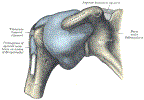 Lewis (1918) Gray's Anatomy 20th ed (in public domain at Yahoo or BartleBy)
Lewis (1918) Gray's Anatomy 20th ed (in public domain at Yahoo or BartleBy) Lewis (1918) Gray's Anatomy 20th ed (in public domain at Yahoo or BartleBy)
Lewis (1918) Gray's Anatomy 20th ed (in public domain at Yahoo or BartleBy)
IV. Anatomy: Muscles (including Rotator Cuff)
-
Muscles attaching Axial skeleton to Scapula
- Trapezius
- Levator Scapulae
- Rhomboids
- Serratus anterior
-
Muscles attaching Axial skeleton to Humerus
- Latissimus dorsi
- Pectoralis major
- Rotator Cuff (mnemonic: SITS Muscles)
- Images

 Lewis (1918) Gray's Anatomy 20th ed (in public domain at Yahoo or BartleBy)
Lewis (1918) Gray's Anatomy 20th ed (in public domain at Yahoo or BartleBy) Lewis (1918) Gray's Anatomy 20th ed (in public domain at Yahoo or BartleBy)
Lewis (1918) Gray's Anatomy 20th ed (in public domain at Yahoo or BartleBy)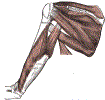 Lewis (1918) Gray's Anatomy 20th ed (in public domain at Yahoo or BartleBy)
Lewis (1918) Gray's Anatomy 20th ed (in public domain at Yahoo or BartleBy)
V. Anatomy: Nerves
- Rotator Cuff is innervated by Brachial Plexus derived nerves
- Suprascapular nerve
- Innervates supraspinatus and infraspinatus
- Axillary nerve
- Subscapular nerve
- Innervates subscapularis
VI. Anatomy: Vessels
- See Vascular Anatomy of the Shoulder
- Artery
- Shoulder
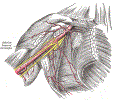 Lewis (1918) Gray's Anatomy 20th ed (in public domain at Yahoo or BartleBy)
Lewis (1918) Gray's Anatomy 20th ed (in public domain at Yahoo or BartleBy) Lewis (1918) Gray's Anatomy 20th ed (in public domain at Yahoo or BartleBy)
Lewis (1918) Gray's Anatomy 20th ed (in public domain at Yahoo or BartleBy) Lewis (1918) Gray's Anatomy 20th ed (in public domain at Yahoo or BartleBy)
Lewis (1918) Gray's Anatomy 20th ed (in public domain at Yahoo or BartleBy)
- Upper Arm
 Lewis (1918) Gray's Anatomy 20th ed (in public domain at Yahoo or BartleBy)
Lewis (1918) Gray's Anatomy 20th ed (in public domain at Yahoo or BartleBy)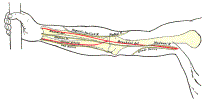 Lewis (1918) Gray's Anatomy 20th ed (in public domain at Yahoo or BartleBy)
Lewis (1918) Gray's Anatomy 20th ed (in public domain at Yahoo or BartleBy)
- Shoulder
- Vein
- Shoulder
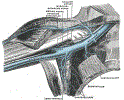 Lewis (1918) Gray's Anatomy 20th ed (in public domain at Yahoo or BartleBy)
Lewis (1918) Gray's Anatomy 20th ed (in public domain at Yahoo or BartleBy)
- Upper Arm
 Lewis (1918) Gray's Anatomy 20th ed (in public domain at Yahoo or BartleBy)
Lewis (1918) Gray's Anatomy 20th ed (in public domain at Yahoo or BartleBy)
- Shoulder
VII. Anatomy: Subacromial Space
- Coracoclavicular arch forms the roof of the subacromial space
- Coracoid process
- Coracoacromial ligament
- Acromion process
- Rotator Cuff
- See Muscles above
- Subacromial bursae
- Separates cuff from overlying coracoacromial arch
- Includes subdeltoid bursa and subcoracoid bursa
- Image
VIII. Physiology: Function
- Shoulder Joint
- Musculature
- Rotator Cuff (Musculotendinous)
- See Muscles above
- Stabilizes humeral head in glenoid
- Results in humeral head descent
- Scapulothoracic Musculature
- Results in forward and lateral Scapula movement
- Initiates first 60-70 degrees of Shoulder Abduction
- Glenohumeral Musculature
- Deltoid and supraspinatus Muscles
- Accounts for last two thirds of Shoulder Abduction
- Rotator Cuff (Musculotendinous)
- Specific Muscle action at Glenohumeral Joint
- Shoulder Abduction
- Shoulder Adduction
- Shoulder Flexion
- Shoulder Extension
- Shoulder Internal Rotation
- Shoulder External Rotation


